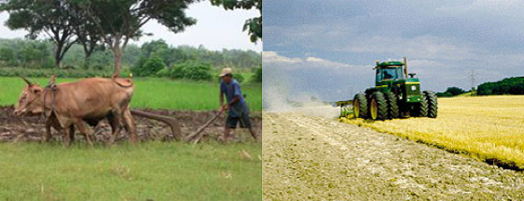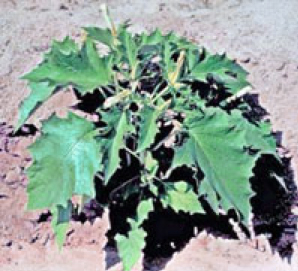Integrated weed management (IWM) and no-till are advanced agronomic tools with common aims to improve efficiency and profitabilty, while reducing the environmental impact of crop production. Although advanced in concept, these tools are straightforward and can be adapted for use in all cropping systems, from highly mechanised ones to subsistence farming, all around the world.
 Plowing: is there a better way?
Plowing: is there a better way?
Tillage is a well proven means of controlling weeds, so are other methods good enough to use in an integrated approach to weed management in no-till systems? This article examines how farmers can reap the rewards of both techniques together.
IWM: A Solution to Weed Shifts and Resistance
Using herbicides greatly simplifies weed control, but relying too heavily on any chemical weedkiller ultimately results in some weed species becoming resistant. Resistance has arisen quickly in some cases, eg to the sulfonylureas, and more slowly, but inevitably, in others, e.g. glyphosate. Resistance to paraquat has only arisen in isolated cases in a few unimportant species over the course of more than 40 years. This is not least due to the way in which paraquat has generally been used in conjunction with other herbicides and cultural weed control methods. Not only herbicides are at issue. Any single approach to weed control will cause the many different weeds in any field to change, or ‘shift’, in terms of their relative competitive pressure on the crop and new species will invade to fill ecological niches left by those most effectively controlled.
Weed resistance and weed shifts have caused researchers and farmers to develop IWM systems which benefit the whole farm. IWM involves using a total agronomy approach to minimise the overall impact of weeds, and indeed, maximise the benefits which the presence of a non-competitive weed cover can give. In IWM, the judicious use of herbicides is incorporated into a system based on cultural methods. These are designed to suppress weed germination or return of seed to the soil, and to offer opportunities to attack particular groups, e.g. spring or autumn germinators. Crop rotations, cover crops, varying row widths, mechanical or manual weed removal are all used. There is no blueprint. Farmers must draw on appropriate techniques to suit the crop, location, season, etc.
No-Till: A Challenge for IWM
Plowing is one IWM technique that can not be used in any no-till system. In conservation agriculture systems, where shallow cultivations are used, but the soil is not inverted, stale seedbeds can be a valuable way of reducing weed pressure. With this technique, light cultivations encourage weed seeds to germinate so seedlings can be destroyed by further cultivations or herbicides. However, even without any soil cultivations, many techniques can be used together very successfully to manage weeds in no-till.
 Thornapple: a highly competitive weed
Farmers recognise that no-till weeds will be different. Annuals which germinate easily on the soil surface (otherwise buried too deep by ploughing to germinate readily) and perennials are much more prolific. Scouting for weeds and knowing how competitive each species is, and, therefore, the relative importance of their removal, is essential.
Thornapple: a highly competitive weed
Farmers recognise that no-till weeds will be different. Annuals which germinate easily on the soil surface (otherwise buried too deep by ploughing to germinate readily) and perennials are much more prolific. Scouting for weeds and knowing how competitive each species is, and, therefore, the relative importance of their removal, is essential.
In Australian cotton, for example, it has been calculated that the threshold weed density for an economic benefit from removal of a large Datura ferox (thornapple) is only 1 plant per 73 metres of cotton row. Apart from the direct competitive effect from shading, use of water and nutrients, thornapple is host to Heliothis, spider mites and Verticillium wilt.
IWM techniques can be divided into:
- General good farming practices: using seed certified weed-free; cleaning combine harvesters between crops; removing mud from tractor wheels when moving between fields.
- Preventative approaches: crop rotation and agronomic practices in each crop to discourage the emergence of weeds, e.g. cover crops, mulches.
- Curative approaches: using various methods to remove weeds when present, e.g. herbicides, flaming.
The major non-cultivation weed control techniques suitable for no-till and their benefits are listed in Table 1.
Table 1. Main IWM techniques applicable to no-till and their advantages or issues.
| Technique | Contribution to Weed Control | Other Benefits or Issues |
|---|---|---|
| Crop rotation | Weeds tend to infest crops with similar features and life-cycles, so rotating between cereals and broadleaved crops, or winter and spring sown crops, helps to contain weeds and offers windows for control | Enriches soil nutrient status, improves soil structure, reduces pest and disease problems |
| Cover crops and mulches | Crops such as rye or wheat sown over winter before planting a spring crop shade out weeds and have an allelopathic effect, i.e. they excrete chemicals which prevent weed seed germination | Protect soil against erosion, provide habitats for benefical organisms, may have a fertilizer value if leguminous |
| Nurse crops and intercropping | Two crops are grown together (in various ways) effectively shading out weeds or ensuring early crop establishment to gain a competitive advantage | Saves time, saves labor and increases overall productivity |
| Higher seed rate or narrow crop rows | Full ground cover is achieved faster, shading out weeds | Can increase yield, but may require more seed |
|
Irrigation management |
Used to encourage flushes of weed emergence |
Water can be a scare resource |
|
Herbicides |
Control weeds as per label |
Save time and labor. Must rotate to avoid resistance and weed shifts. Important not to remove uncompetitive species unnecessarily |
| Mowing |
Temporarily removes weeds or cover crop while maintaining ground cover |
May need several mowings and therefore demanding on time and fuel use |
|
Flame weeding or other thermal methods (boiling water, foam) |
May give broad spectrum control |
Requires repeat treatments and only effective at susceptible growth stages and where growing points are exposed. Fire hazard |
|
Manual weeding |
Selective removal of escapes or low density weeds |
Effective if weeds have not been allowed to shed seed, but can be laborious and time consuming with delays to planting |
Less widespread methods not listed in Table 1 include
- Brush weeding, where fast rotating brushes uproot weeds; minimising herbicide use by, e.g. band spraying or using impregrated rope wicks to smear a systemic herbicide on weeds taller than the crop
- Varying crop sowing dates to attack weeds tending to emerge at different times
- Using animals such as geese to selectively remove palatable weeds
Some other biological control methods have been used. Often, however, these have generally been applied in non-agricultural situations. The weevil Hylobius transversovittatus has been introduced to control purple loosestrife (Lythrum salicaria) in wetlands of many American states. Although common problem field weeds such as pigweeds have been targeted, biological control methods are usually highly selective for single weed species.
Using any individual method in IWM has consequences for the rest of the system. For instance, moving between crops in the rotation will mean selecting from a different range of herbicides and choosing one herbicide will mean that another with a different mode of action should be selected next time. This rotation of herbicides as well as crops will significantly reduce weed shifts and the development of resistance. Computer-based decision tools to assist making complex decisions about the compatibility and effectiveness of various IWM methods are now available. One example is the RIM model developed in Western Australia to select the best ways of controlling herbicide resistant annual ryegrass (Lolium rigidum).
Role of Paraquat: Economic, Social and Environmental Benefits
When it comes to using herbicides in IWM paraquat is an ideal choice, especially in no-till systems. As a broad spectrum, non-selective herbicide, paraquat removes almost all weed growth. Its fast and reliable action in all weathers, including when there are only short intervals to spray between rain showers and when it is cold, means that it has huge flexibility to fit in to IWM systems. It is particularly useful in situations varying from burning down weeds or cover crops in cold, wet springs, to quickly removing weeds in between crops in double cropping systems in much warmer climates.
References
Buhler, DD (2002). Challenges and opportunities for integrated weed management. Weed Science, 50, (3), 273–280
Burki, HM, et al. (1997). Biological control of pigweeds (Amaranthus retroflexus, L. A. Powellii, S. Watson and A. Bouchonii Thell.) with phytophagous insects, fungal pathogens and crop management. Integrated Pest Management Reviews, 2, (2), 51-59.
Humphreys, E, et al. (2006). Increasing field scale water productivity of rice-wheat systems in the Indo-Gangetic Basin. International Rice Congress, 9-13 October 2006, New Delhi.

